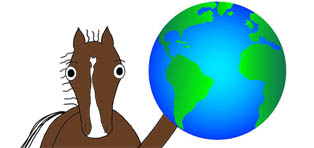Inside.FEI.org
11 Apr 2017
The welfare of equines and human athletes was top of the agenda on day two of the FEI Sports Forum 2017. Scientific data on Eventing risk management, Endurance risk factors and bone fatigue was presented to more than 330 delegates gathered at the International Institute for Management Development in Lausanne (SUI) today.
The FEI has invested in substantial scientific research to evaluate risk factors and risk management and the sixth edition of the Sports Forum provided the platform for evidence-based data to be presented to the equestrian community.
Sydney 2000 Olympic champion David O’Connor (USA), Chair of the FEI Eventing Risk Management Steering Group, shared moderation of the afternoon session on Eventing Risk Management with Giuseppe Della Chiesa (ITA), chair of the FEI Eventing Committee.
David O’Connor, who was also involved in the Hartington Report into risk management in the sport in 2000, remembered how Formula 1 driver Jackie Stewart had given him two messages: “If you have the technology and the ability you have to use it, and you will always be behind the curve, you will never think of everything.”
Co-founders of equestrian data science company EquiRatings, Diarmuid Byrne and Sam Watson, who signed a four-year partnership with the FEI earlier this month to work on risk management initiatives for Eventing, presented the rationale behind the EquiRatings Quality Index (ERQI) and its scope, with analysis of athlete and horse performance history one of the key elements in risk reduction in Eventing.
“Past performance helps us predict and plan future performance”, EquiRatings Managing Director Diarmuid Byrne said.
The Irish company is also working with a number of National Federations and their work in Ireland saw a 66% reduction in falls at national level last year. “It’s about introducing a mind-set of rider responsibility. Psychologically we don’t look at risk, and this tool allows us to step in when we ignore it.”
Presentations in the following session on Endurance risk factors and bone fatigue were well received by delegates, who were impressed by the detailed analysis of data. All three of the panellists - Dr Tim Parkin and Dr Euan Bennet from the University of Glasgow, who are conducting the FEI’s Global Endurance Injuries Study, and Professor Chris Whitton from the University of Melbourne, were clear on the fact that speed and non-compliance with mandatory rest periods are the key risk factors.
Dr Euan Bennett stated that an increase of seven days on the mandatory rest periods established in 2014 could potentially prevent 10% of the failed-to-qualify statistics.
Professor Chris Whitton spoke about how intensive training results in an accumulation of damage and the inhibition of bone repair that occurs during rest. “Prevention is the key”, he said. “Once you’ve got the injury it’s too late. It may not be a catastrophic injury but that horse’s career is shortened. It’s not speed alone, and it’s not distance alone, it’s a combination of the two.”
In her wrap-up of key takeaways from the Endurance session, FEI Secretary General Sabrina Ibáñez said: “We really need to be attuned to our horses. We need to listen to them. They are equine athletes and they really need and deserve recovery time.”
Mark Samuel (CAN), Chair of the FEI Working Group on FEI Officials opened the day’s first session when details of 13 concrete recommendations were provided, including a code of conduct and job descriptions for officials, the withdrawal of the age limit, online education for officials and course directors, appointments and remuneration, and a mentoring programme for younger officials,.
Delegates were also gjven an update on the initial findings of the FEI Dressage Judging Working Group. The Group’s discussions, which have lasted for several months, were based on analytical studies of the current judging system and exploring judging procedures in other FEI disciplines, such as Reining and Vaulting.
The need to introduce a code of points and to concentrate further on education and training of judges across all levels are some of the long-term objectives proposed by the Working Group, with a revised multi-media FEI Dressage Handbook to be delivered as support.
FEI President Ingmar De Vos closed the FEI Sports Forum 2017 by thanking delegates and sponsors, and saying: “We’re very proud of the Sports Forum. This is what we need to do to fully engage with our community and take the necessary next steps. It is very important for the FEI to listen to what our National Federations and stakeholders have to say. The end of the Sports Forum means the start of a lot of work, but this is always a positive move forward.
“It was great to have so many young people contributing to the success of this year’s Sports Forum, and we very much hope to increase the participation of our youth in other editions of the Sports Forum.”
Panellists:
Officials: Mark Samuel, Group IV Chair – Moderator; Peter Bollen, FEI Jumping Committee member, Sönke Lauterbach, NF Germany Secretary General; Frances Heather Hesketh-Jones Triulzi, FEI Honorary Steward General Jumping; Brigitte Mathias, NF Namibia Secretary General.
Risk Management in Eventing: David O’Connor (USA), Chair FEI Eventing Risk Management Steering Group and Sydney 2000 Olympic champion; Giuseppe Della Chiesa (ITA), chair of the FEI Eventing Committee; Equiratings’ Diarmuid Byrne and Sam Watson.
Endurance risk factors and Bone Fatigue: Chair of the FEI Veterinary Committee John McEwen; Chair of the FEI Endurance Committee Brian Sheahan; Dr Tim Parkin and Dr Euan Bennet at the University of Glasgow; Professor Chris Whitton from the University of Melbourne.
FOR IMMEDIATE RELEASE SOURCE: ENDURANCE.NET AlUla Organizing Committee Commits to Track Modifications Ahead of February Showdown ALULA, KS...

-
Inside.fei.org 17 December 2020 The FEI Board took a series of key decisions on allocation, cancellation, and reopening of bids for FEI C...
-
Michael Pollard was one of the four winners of the 2025 Mongol Derby (Kathy Gabriel) Ca.News.yahoo.com - Full Article Annabel Grossman ...
-
BNA.bh - Full Article 17 Aug 2025 London, Aug. 17 (BNA): His Highness Shaikh Nasser bin Hamad Al Khalifa, Representative of His Majes...

